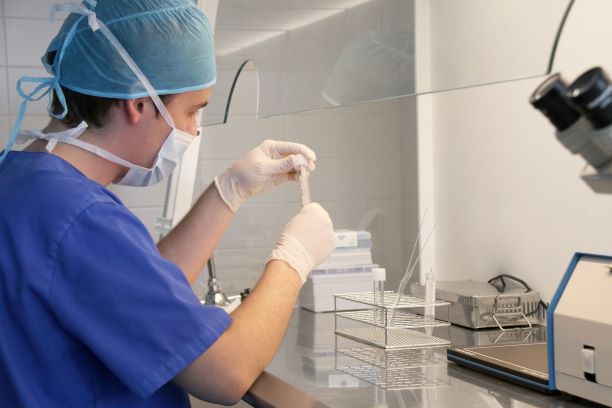
Spermiogramme and Advanced Semen Studies (FISH AND TUNEL)
One of the basic studies done to determine the male’s sperm quality is the seminogramme , also known as spermiogramme. We would need a sperm sample to carry it out (see how to take the sample correctly). Sperm is analysed from macroscope and microscope point of view.
Índice
What is the seminogramme?
The most relevant parameters of the study are threefold:
- Sperm count
- Sperm motility
- Sperm morphology
The values considered normal for these parameters have been updated in the latest manual of the World Health Organisation (WHO) which was published in 2010.
Regarding the sperm count, we consider from 15 million spermatozoids per millilitre of semen as normal.
The WHO currently distinguishes three categories with regards to sperm motility:
- Progressively motile sperm
- Non-progressively motile sperm
- Stationary Sperm
To be considered to possess normal motility we should observe at least 32% progressively motile sperm. We can visually illustrate the difference between a normal sperm sample and a low quality one which take into account the parametres of count and motility via these two videos.
As for sperm morphology we can observe both normal sperm as well as sperm with abnormalities, either at the head or tail.
A sperm sample is considered normal if we find at least 4% of normal forms as per the strict Krugger criteria. Semen analysis is therefore an important test in deciding upon the most appropriate assisted reproduction technique to be applied in each case.
Sperm advanced studies
However, the parametres obtained through a conventional semen analysis does not provide complete information about the fertilising potential of semen and the ability to lead to a healthy embryo and an on-going pregnancy. A comprehensive study of male factor and its contribution to fertility issues in couples is required to determine other parameters such as sperm DNA fragmentation index or aneuploidies in sperm.
TUNEL: sperm DNA fragmentation
It has been shown that infertile men have a higher sperm fraction with ruptures in their DNA, and that this may have a negative impact on the outcome of assisted reproduction techniques, since the transmission of the full DNA molecule from the sperm to the oocyte is essential for the attainment and development of pregnancy. An increase in the population of sperm with fragmented DNA may be responsible for blocking embryonic implantation failures and miscarriages. The technique we use for determining sperm DNA fragmentation is called TUNEL, which measures the existing breaks in the DNA strand incorporating fluorescently marked molecules.
FISH: Sperm aneuploidy
Another very useful diagnostic technique for the analysis of sperm is fluorescence in situ hybridisation (FISH), which allows us to analyse part of the sperm chromosome, in particular, chromosomes 13, 18, 21, X and Y which are mainly involved in miscarriage and foetal malformations. Sperm with a high percentage of chromosomally abnormal spermatozoids may lead to implantation failures, miscarriage or chromosomal abnormalities in offspring.
Dr Ana Fabregat, Pharmacist and Dr Ruth Morales, Biologist at Instituto Bernabeu.
IT MAY ALSO BE OF INTEREST TO YOU
- First fertility appointment
- Male infertility
- When should I see a fertility specialist?
- In Vitro Fertilization (IVF)
- Andrology
- Implantation failure and recurrent miscarriage Unit
- Instructions for correct collection of semen samples: abstinence, hygiene, etc
